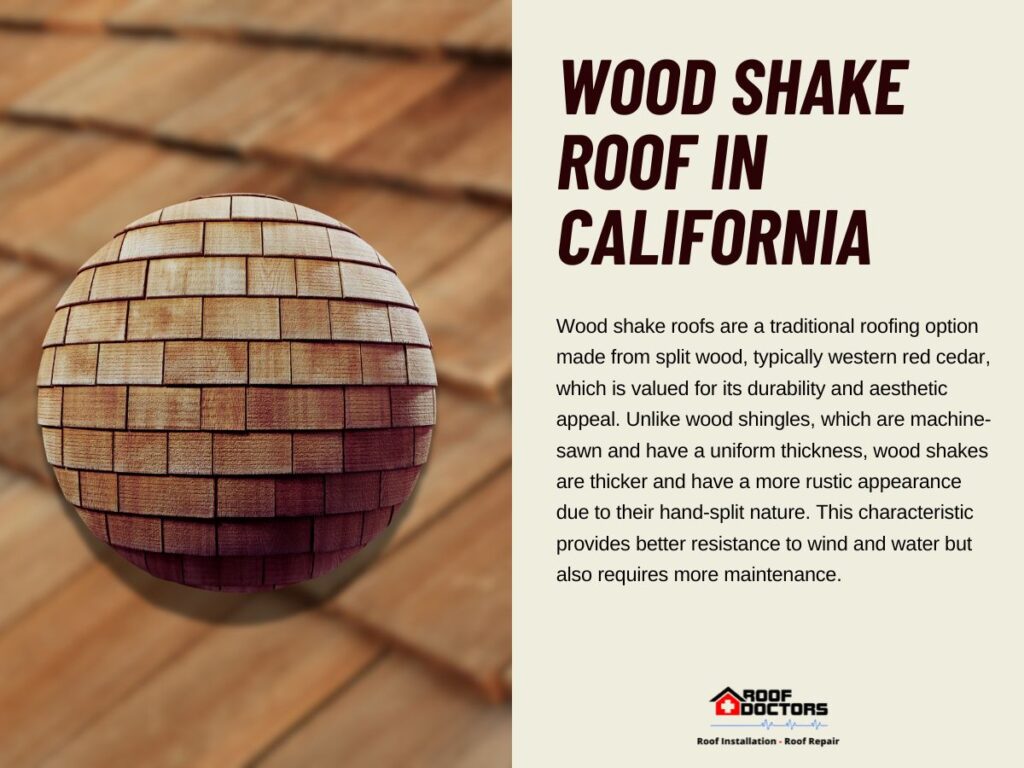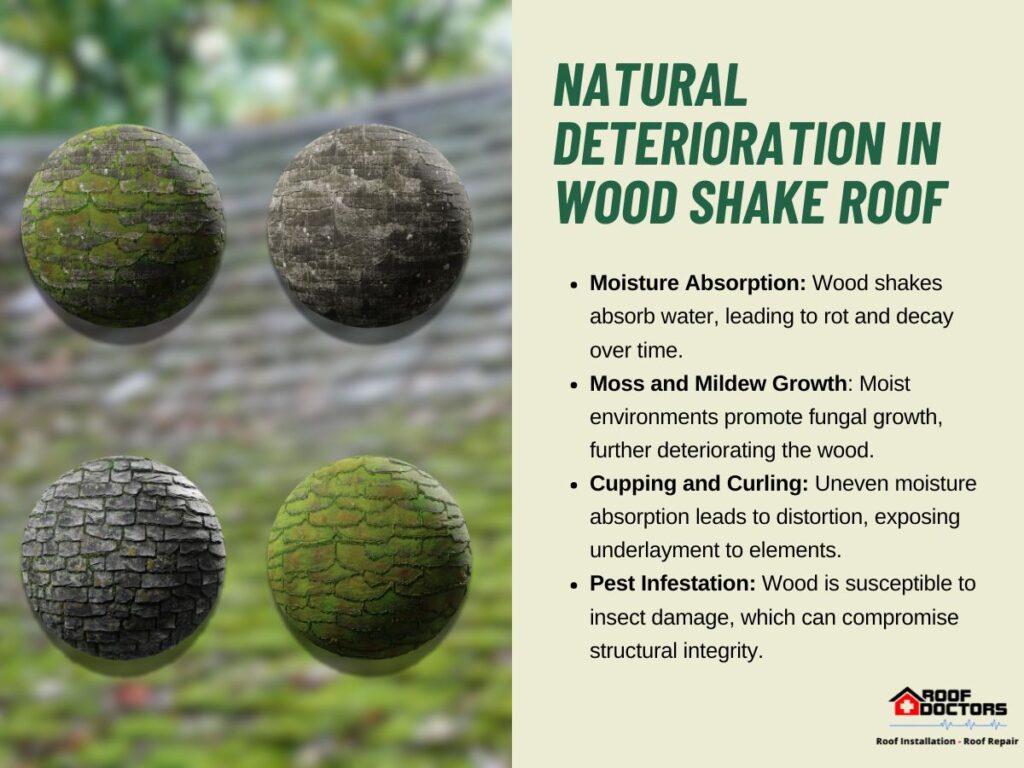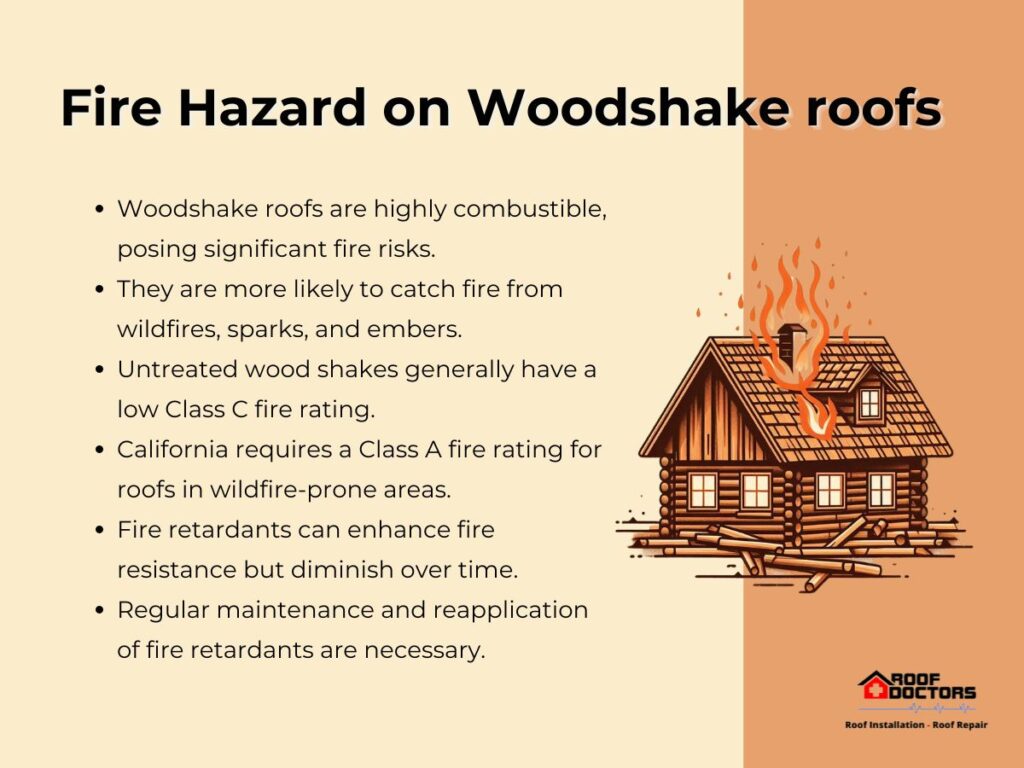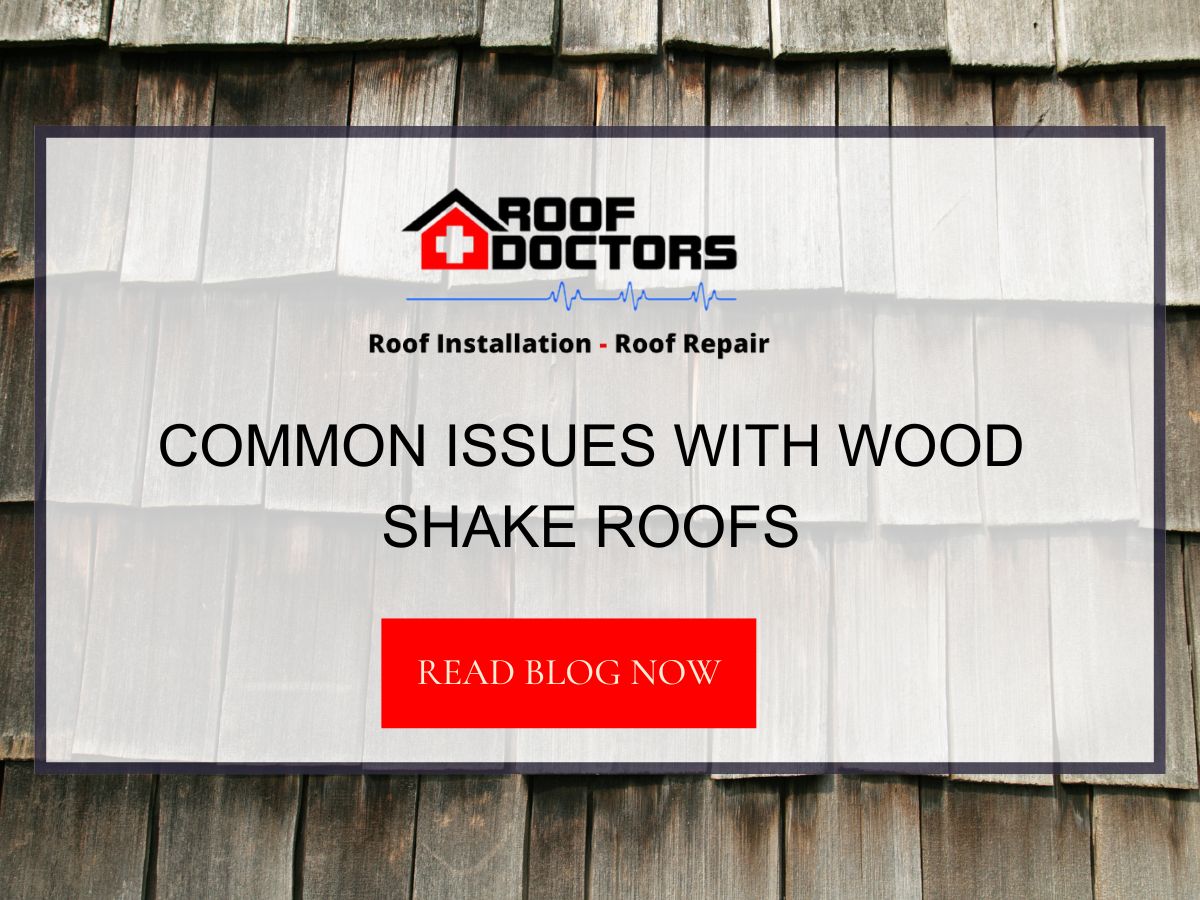Wood shake roofs have a timeless charm, offering a rustic and natural look that many homeowners love. If you have a wood shake roof or are considering one, it’s important to be aware of the common issues that come with this type of roofing.
While they look beautiful and can enhance the character of your home, wood shake roofs require a significant amount of upkeep and come with their own set of challenges. Understanding these potential problems can help you make informed decisions about maintenance and whether this roofing style is right for your home.

Maintenance
Maintaining your wood shake roof is crucial to ensuring it lasts as long as possible. Without regular care, small issues can quickly become major problems, leading to costly repairs or even the need for a full roof replacement.
Whether you’re dealing with routine cleanings or need to make minor repairs, knowing what to look for and how to address it can save you a lot of trouble down the road.
1. Importance of Regular Maintenance
Taking the time to regularly maintain your wood shake roof can make a huge difference in its lifespan and performance. It’s not just about preventing damage; it’s also about catching issues early before they become more serious. Regular maintenance helps you stay ahead of potential problems and ensures your roof remains sturdy and reliable.
A well-maintained roof is less likely to suffer from issues like moss growth or rot, which can detract from your home’s appearance and value.
2. Consequences of Neglecting Maintenance
Neglecting maintenance can lead to a host of problems that are both expensive and time-consuming to fix. Small issues like cracked or missing shingles can quickly escalate, causing leaks and water damage inside your home.
By the time you notice these problems, the damage may already be extensive. In addition to structural damage, failing to maintain your roof can also reduce its lifespan.
Wood shake roofs are a significant investment, and without proper care, you may find yourself needing a replacement much sooner than expected.
Natural Deterioration
Over time, wood shake roofs naturally deteriorate due to exposure to the elements. This is a normal process, but understanding what to expect can help you better manage and mitigate these changes.
Natural deterioration affects the structural integrity and appearance of your roof, making regular inspections and proactive care essential.

1. Rot
Rot is one of the most common issues with wood shake roofs. It occurs when the wood retains moisture over a prolonged period, leading to the breakdown of its fibers.
This can happen due to poor ventilation, trapped debris, or prolonged exposure to rain and snow. Rot not only weakens the wood but also makes it more susceptible to other problems like insect infestations and mold.
2. Moss and Mildew Growth
Moss and mildew thrive in damp environments, making wood shake roofs an ideal habitat if they’re not properly maintained. These growths can trap moisture against the wood, accelerating the deterioration process and leading to rot.
Moss and mildew can also make your roof look unsightly. Regularly removing moss and applying treatments can help keep these growths under control.
3. Pests, Insects, & Termites
Wood shake roofs are particularly attractive to pests like termites, carpenter ants, and other insects that feed on or nest in wood. These pests can cause significant structural damage if not addressed quickly.
Look for small holes, sawdust, or other indicators of insect presence. Treating your roof with pest-resistant products and ensuring there are no conducive conditions for pests can help protect your roof from these unwelcome invaders.
4. Curling and Cupping
Curling and cupping occur when the edges of wood shakes start to lift and bend. This can be caused by excessive moisture, extreme temperatures, or age.
When shakes curl or cup, they no longer lie flat against the roof, which can compromise the roof’s ability to shed water effectively. Replacing affected shakes and ensuring your roof is properly ventilated can help mitigate this issue.
5. Split Shingles
Wood shakes can split due to factors like weather changes, physical impact, or age. Splits can start small but can quickly grow larger, creating gaps that allow water to penetrate your roof.
Regularly inspecting your roof and replacing split shingles can help prevent more serious damage. It’s also important to use high-quality wood shakes that are less prone to splitting and to maintain proper ventilation to reduce stress on the shingles.
6. Missing Shingles
Severe weather, high winds, and physical impact can cause wood shakes to become loose or fall off entirely. Missing shingles leave your roof vulnerable to water damage and other issues.
It’s important to replace missing shingles as soon as possible to maintain the integrity of your roof. Regular inspections, especially after storms, can help you catch and address this issue quickly.
Physical Damage
Physical damage to your wood shake roof can occur from various sources, including weather, impact, and general wear and tear. These damages not only affect the appearance of your roof but also its functionality and lifespan.
Addressing physical damage promptly can help prevent more serious issues down the line.
1. Curling and Cupping
Curling and cupping are common problems with wood shake roofs. When the edges of the shakes lift and curl upwards, it can create gaps where water can seep through.
This often happens due to excessive moisture, temperature fluctuations, or simply the natural aging of the wood. If left untreated, these issues can lead to leaks and more extensive water damage inside your home.
2. Split Shingles
Shingles on your wood shake roof can split for various reasons, including weather changes, physical impact, or simply old age. Split shingles can lead to gaps that allow water to penetrate, causing leaks and water damage to your home.
Identifying and replacing split shingles quickly can prevent these problems from escalating. Ensure you use high-quality replacement shakes and maintain proper roof ventilation to minimize the risk of splitting.
3. Missing Shingles
High winds, severe weather, and physical impacts can cause shingles to become loose or fall off your roof. Missing shingles create vulnerabilities in your roof that can lead to water infiltration and other damage.
After any significant weather event, it’s important to inspect your roof for missing shingles and replace them promptly. Keeping your roof complete and intact is essential for protecting your home from the elements.
Cost Considerations
When it comes to wood shake roofs, the costs can add up quickly. From installation to maintenance and potential repairs, it’s important to have a clear understanding of what you’re getting into financially.
Knowing these costs upfront can help you plan better and make more informed decisions about your roofing options.
1. Installation Costs
The initial installation of a wood shake roof is typically more expensive than other roofing materials. The cost can range from $6 to $9 per square foot, depending on the quality of the wood and the complexity of the roof design.
For an average-sized home of 2,000 square feet, you might expect to pay between $12,000 and $18,000 for a new wood shake roof. These costs include materials and labor, but additional expenses may arise if your roof has special features or requires extensive preparation work.
2. Maintenance Costs
Regular maintenance is essential for keeping your wood shake roof in good condition. Annual inspections and cleaning can cost around $200 to $400.
However, more extensive maintenance, such as treating the wood with preservatives or replacing damaged shakes, can increase these costs. Budgeting for these ongoing expenses is important to ensure you can address issues as they arise and prevent more significant problems.
3. Repair Costs
Despite your best efforts, repairs will eventually be necessary. The cost of repairs can vary widely depending on the extent of the damage.
Minor repairs, such as replacing a few damaged shakes, might cost $300 to $600. More extensive repairs involving larger sections of the roof can run into the thousands.
For example, repairing a 10-foot by 10-foot section of a wood shake roof could cost between $700 and $1,500, depending on the severity of the damage and the cost of materials.
Fire Hazard
Woodshake roofs, while beautiful, come with a significant fire risk. The natural combustibility of wood means that these roofs are more susceptible to fire than other roofing materials, posing a danger to your home and family.
This makes wood-shake roofs inherently more likely to catch fire, especially in dry or wildfire-prone areas. The risk is not just from external sources like wildfires but also from sparks from chimneys, nearby fireworks, or even embers from a backyard fire pit.

1. Low Fire Rating
Woodshake roofs generally have a low fire rating unless treated with fire retardants. Fire ratings classify materials based on their ability to withstand fire exposure. Class A is the highest rating, providing the most fire resistance, while Class C is the lowest, offering minimal protection.
Most untreated wood shake roofs fall into the Class C category, which means they are not highly resistant to fire. This can be a major concern in areas prone to wildfires or where local building codes require higher fire resistance.
2. Fire Rating Requirements in California
California, known for its wildfire risks, has stringent fire rating requirements for roofing materials. In many parts of the state, roofs must meet a Class A fire rating to comply with building codes.
This high standard is designed to enhance the safety of homes and reduce the spread of fires. If you live in California or another area with similar regulations, ensuring your wood shake roof meets these requirements is essential.
This might involve treating the wood with fire retardants or considering alternative materials that offer higher fire resistance.
3. Loss of Fire Resistance Over Time
Even if your wood shake roof is initially treated with fire retardants to achieve a higher fire rating, this protection can diminish over time. Weathering, UV exposure, and other environmental factors can reduce the effectiveness of fire retardants, lowering the roof’s fire resistance.
Regular maintenance and reapplication of fire retardants can help maintain the fire resistance of your roof. However, it’s important to recognize that these treatments need to be reapplied periodically to remain effective.
4. Mitigation Strategies
There are several steps you can take to reduce the fire hazard associated with wood shake roofs:
- Fire Retardant Treatments: Apply and reapply fire retardant treatments to your wood shakes to improve their fire rating.
- Regular Maintenance: Keep your roof clear of debris, leaves, and other materials that could catch fire easily.
- Gutter Guards: Install gutter guards to prevent leaves and debris from accumulating and becoming a fire hazard.
- Chimney Screens: Use chimney screens to prevent sparks from escaping and landing on the roof.
- Firebreak Landscaping: Maintain a defensible space around your home by keeping vegetation trimmed and creating firebreaks with gravel or stone.
Preserving The Beauty Of Wood Shake Roofs: Maintenance And Repair Tips
Woodshake roofs offer a unique and charming aesthetic that many homeowners cherish, but they come with their own set of challenges and risks. By staying informed and proactive, you can address these problems early, saving yourself time and money while preserving the beauty and functionality of your wood shake roof.
The principles of preserving the beauty of wood shake roofs through proper maintenance and repair are directly relevant to the common issues they face. Regular maintenance is the cornerstone of preventing natural deterioration, addressing physical damage promptly, and maintaining the roof’s fire resistance.
A consistent maintenance routine helps retain the natural charm of wood shake roofs, preventing unsightly damage such as curling, splitting, and uneven fading. This approach not only enhances the longevity and safety of your roof but also ensures that its rustic beauty remains intact for years to come.


